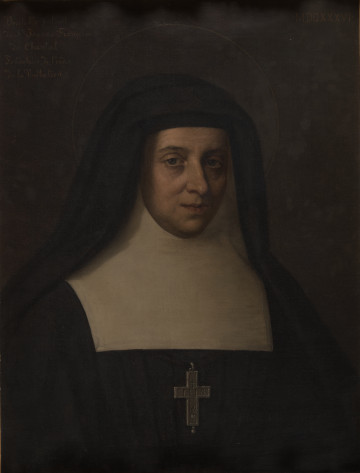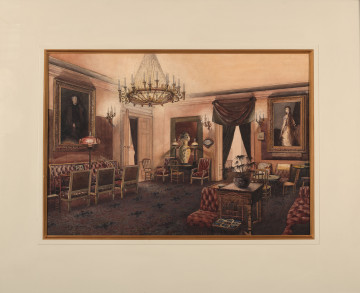
Joanna de Chantal
2nd half of the 19th century
Castle Museum in Łańcut
Part of the collection: Malarstwo i rysunek
The painting depicts Mary with a sleeping Child Jesus on her lap, accompanied by Saint Joseph and a youthful John the Baptist. John the Baptist is pointing to the Child. This type of depictions was quite popular. In Hebrew, the name “John” means “graced by Yah” or “Yahwe is Gracious”, referring to the annunciation of John’s birth to Zechariah, his father, while the latter made an offering before an altar. John’s parents were elderly and they had no children, since Elizabeth was barren. Zechariah did not believe the vision and the angel’s announcement, and remained mute until John’s birth. When the Archangel Gabriel appeared to Mary to tell her of Jesus’ birth, he also told her that her relative, Elizabeth, who had been considered barren, was six months pregnant. Mary then set out to visit Elizabeth. When they met, Elizabeth greeted Mary and told her that at the sound of Mary’s voice, the child in her womb (John the Baptist) moved with joy. The scene has been described in the Gospel. In the Łańcut painting, Saint John is pointing to Jesus as the future Saviour (the Child is sleeping on a piece of white fabric, which heralds the shroud the Saviour would be buried in). Saint John is presented with one of his attributes – a cross with a long stem, wrapped in a banner bearing the inscription Ecce Agnus Dei (Behold, the Lamb of God). The painting is ascribed to Italian painter Mattia Preti, known as Il Cavalier Calabrese (born 1613 in Taverna, died 1699 in Valletta). He worked during the Baroque period under the influence of the work and style of Caravaggio. He spent his youth in Naples, left for Rome in 1630, and travelled extensively in northern Italy. In 1642, he was appointed as a Knight of the Order of St John (Knight of Malta), and in 1661, he moved to Malta and remained there until his death. Initially, he painted genre scenes, and later, mainly religious ones. His works were characterised by rich, vibrant colours and the way he handled light. His period of activity (he also created frescoes) lasted 60 years, and he was one of the most important representatives of Neapolitan painting.
Author / creator
Dimensions
height: 124 cm, width: 99 cm
Object type
Painting and drawing
Technique
oil
Material
canvas
Origin / acquisition method
decyzja administracyjna
Creation time / dating
Creation / finding place
Owner
Castle Museum in Łańcut
Identification number
Location / status

2nd half of the 19th century
Castle Museum in Łańcut

2nd half of the 18th century
Castle Museum in Łańcut

19th (?) century
Castle Museum in Łańcut
DISCOVER this TOPIC
Museum of King Jan III's Palace at Wilanów
DISCOVER this PATH
Educational path